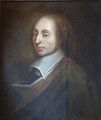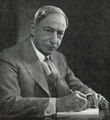Template:Selected anniversaries/August 19: Difference between revisions
No edit summary |
No edit summary |
||
| (2 intermediate revisions by the same user not shown) | |||
| Line 6: | Line 6: | ||
||1646: John Flamsteed born ... astronomer and academic. Pic. | ||1646: John Flamsteed born ... astronomer and academic. Pic. | ||
File:Blaise Pascal.jpg|link=Blaise Pascal (nonfiction)|1662: Mathematician, physicist, inventor, writer, and Christian philosopher [[Blaise Pascal (nonfiction)|Blaise Pascal]] dies. | File:Blaise Pascal.jpg|link=Blaise Pascal (nonfiction)|1662: Mathematician, physicist, inventor, writer, and Christian philosopher [[Blaise Pascal (nonfiction)|Blaise Pascal]] dies. Pacal did pioneering work on calculating machines. | ||
||1692: Salem witch trials: In Salem, Province of Massachusetts Bay, five people, one woman and four men, including a clergyman, are executed after being convicted of witchcraft. | ||1692: Salem witch trials: In Salem, Province of Massachusetts Bay, five people, one woman and four men, including a clergyman, are executed after being convicted of witchcraft. | ||
| Line 29: | Line 29: | ||
File:Jean Baptiste Joseph Delambre.png|link=Jean Baptiste Joseph Delambre (nonfiction)|1822: Mathematician and astronomer [[Jean Baptiste Joseph Delambre (nonfiction)|Jean Baptiste Joseph Delambre]] dies. He was one of the first astronomers to derive astronomical equations from analytical formulas. | File:Jean Baptiste Joseph Delambre.png|link=Jean Baptiste Joseph Delambre (nonfiction)|1822: Mathematician and astronomer [[Jean Baptiste Joseph Delambre (nonfiction)|Jean Baptiste Joseph Delambre]] dies. He was one of the first astronomers to derive astronomical equations from analytical formulas. | ||
||1830: Julius Lothar Meyer born ... chemist who discovered the Periodic Law, independently of Dmitry Mendeleyev, at about the same time (1869). However, he did not develop the periodic classification of the chemical elements as thoroughly as Mendeleyev. Meyer trained originally in medicine and chemistry. He examined the effect of carbon monoxide on blood. In 1879, Meyer compared atomic volume to atomic weight. Plotted on a graph, the curve showed the periodicity of the elements. He also established the concept of valency by indicating that a given element combined with a characteristic number of hydrogen atoms, and coined the terms like univalent, bivalent, and trivalent, based on that number. Pic. | ||1830: Julius Lothar Meyer born ... chemist who discovered the Periodic Law, independently of Dmitry Mendeleyev, at about the same time (1869). However, he did not develop the periodic classification of the chemical elements as thoroughly as Mendeleyev. Meyer trained originally in medicine and chemistry. He examined the effect of carbon monoxide on blood. In 1879, Meyer compared atomic volume to atomic weight. Plotted on a graph, the curve showed the periodicity of the elements. He also established the concept of valency by indicating that a given element combined with a characteristic number of hydrogen atoms, and coined the terms like univalent, bivalent, and trivalent, based on that number. Pic. | ||
| Line 121: | Line 119: | ||
File:Giant Red Ball in Toledo Ohio.jpg|link=Toledo giant red ball incident (nonfiction)|2015: A [[Toledo giant red ball incident (nonfiction)|giant red ball breaks loose from an art installation and rolls down the street]] in Toledo, Ohio. | File:Giant Red Ball in Toledo Ohio.jpg|link=Toledo giant red ball incident (nonfiction)|2015: A [[Toledo giant red ball incident (nonfiction)|giant red ball breaks loose from an art installation and rolls down the street]] in Toledo, Ohio. | ||
</gallery> | </gallery> | ||
Latest revision as of 12:12, 7 February 2022
1662: Mathematician, physicist, inventor, writer, and Christian philosopher Blaise Pascal dies. Pacal did pioneering work on calculating machines.
1758: Jean-Étienne Montucla received the censor's approbation for his Histoire des mathematiques, which is justly famous as a history of the mathematical sciences.
1822: Mathematician and astronomer Jean Baptiste Joseph Delambre dies. He was one of the first astronomers to derive astronomical equations from analytical formulas.
1906: Inventor Philo Farnsworth born. He will make many crucial contributions to the early development of all-electronic television.
1913: Computer scientist, engineer, and academic John Argyris born. A pioneer of computer applications in science and engineering, Argyris will be among the creators of the finite element method.
1923: Engineer, sociologist, economist, political scientist, and philosopher Vilfredo Pareto dies. He applied mathematics to economic analysis, asserting that the distribution of incomes and wealth in society is not random and that a consistent pattern appears throughout history, in all parts of the world and in all societies.
1967: Inventor, writer, editor, and publisher Hugo Gernsback dies. He published the first science fiction magazine, and had a profound influence on the development of science fiction.
1993: Actor-cryptographer Niles Cartouchian confirms that he personally designed the computational security protocols featured in the action-adventure film Dard Hunter, Glyph Warden.
1994: Chemist, biochemist, peace activist, author, and educator Linus Pauling dies.
2015: A giant red ball breaks loose from an art installation and rolls down the street in Toledo, Ohio.









